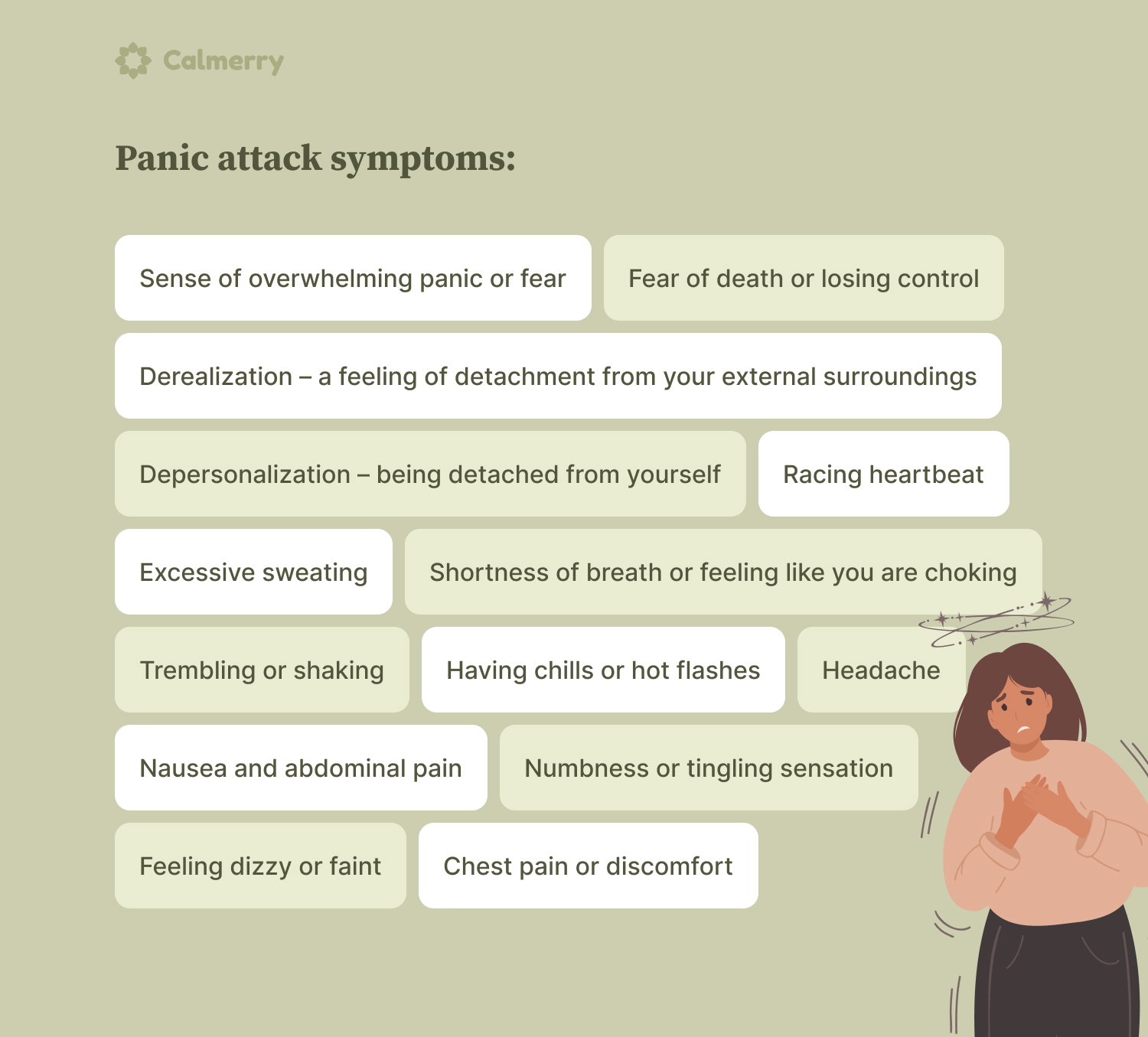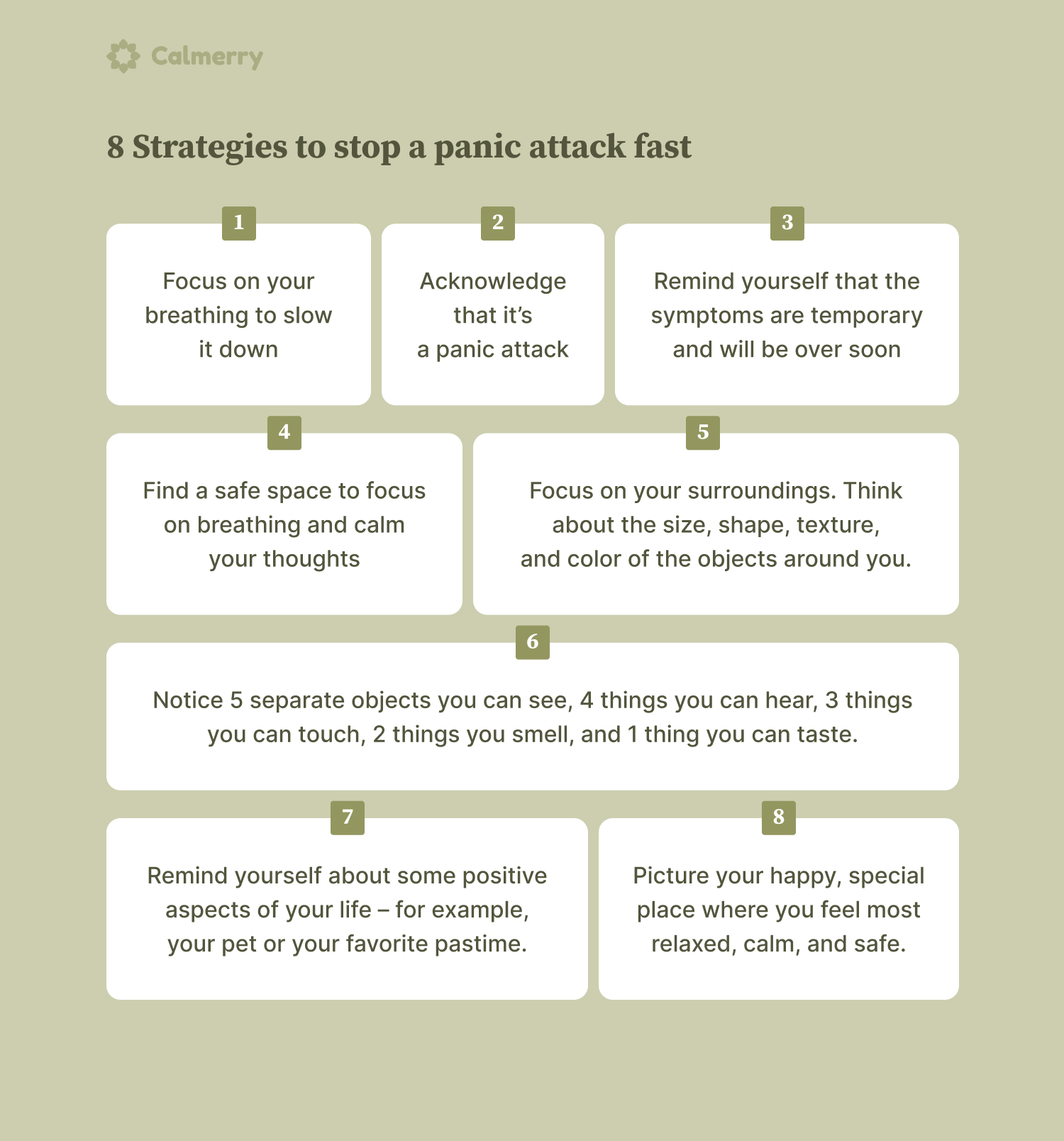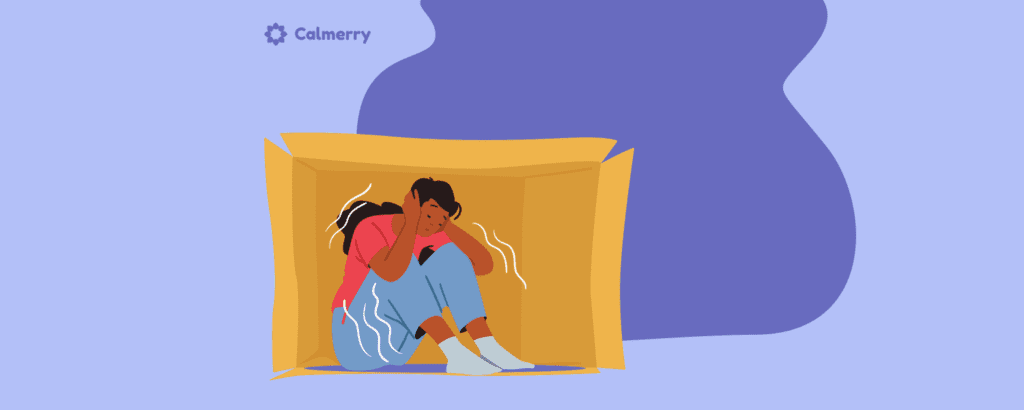How to Stop Panic Attacks and Prevent Them from Happening

In this article
When you have a panic attack, it feels really scary, and you may have an overwhelming feeling that something terrible is about to happen, although you know it’s not true. Your heart may pound, you may sweat, and you feel like you can’t just breathe or think.
The worst thing is that panic attacks may occur unexpectedly without any obvious trigger. And you always feel worried about the possibility of having another one at any time. So you may even become scared of going out alone and visiting public places. But it’s important not to let that fear control your life.
Here, we’ll talk about the physical and mental symptoms of panic attacks, their causes, risk factors, and treatment options. You’ll also learn how to stop a panic attack fast and prevent further attacks from happening.
What is a panic attack?
A panic attack is a sudden and often unexpected episode of intense fear that may include severe physical symptoms – for example, a racing heartbeat, shortness of breath, chest pain, or nausea.
Panic attacks often strike out of the blue when there is no danger or apparent reason. You may have a panic attack even when you are relaxed or asleep.
A panic attack can be really frightening, and you may even think that you are having a heart attack, dying, or going crazy. The fear and terror that you experience during panic attacks are not in proportion to the real situations and may be unrelated to what is happening around you.
Types of panic attacks
Panic attacks can differ in intensity and duration and can be expected and unexpected.
Many people have expected panic attacks that occur in response to specific triggers. For example, if you have a fear of enclosed spaces – or claustrophobia – you may experience panic attacks when you are in some cramped areas, such as an elevator.
Unexpected panic attacks occur suddenly without any indication or obvious cause. You might be completely relaxed when symptoms start to develop. There are no conscious internal cues, like feelings of intense anxiety or fearful thoughts, and no external cues, such as experiencing a frightening situation or event or a specific phobia.
How long can a panic attack last, and what are its symptoms?
Most panic attacks last between 5 to 20 minutes, and the symptoms are usually at their worst within the first 10 minutes. In extreme cases, symptoms may last for more than an hour.
When you are having a panic attack, your body may react in different ways. The panic attack symptoms may include:
- Sense of overwhelming panic or fear
- Fear of death or losing control
- Derealization – a feeling of detachment from your external surroundings
- Depersonalization – being detached from yourself
- Racing heartbeat
- Excessive sweating
- Shortness of breath or feeling like you are choking
- Trembling or shaking
- Having chills or hot flashes
- Feeling dizzy or faint
- Chest pain or discomfort
- Nausea and abdominal pain
- Numbness or tingling sensation
- Headache
But although physical and mental symptoms of panic attacks are intense and frightening, panic attacks are not dangerous. They won’t cause you any physical harm, although you might feel drained and exhausted afterward.
They can also cause excessive stress and have a negative impact on your quality of life. But if you learn to recognize the signs that a panic attack is coming on, you can find ways to stop it.

Panic attack vs. panic disorder
Panic attacks can happen to anyone, and many people can have only one or two in their lifetime without further episodes or complications.
If you have just one or two incidents, probably, you don’t need to worry. But if you have recurrent and unexpected panic attacks and can’t stop worrying about having new episodes, it may be a sign of panic disorder.
So what is the difference between a panic attack and panic disorder? Panic attacks are a symptom, and panic disorder is a mental health condition. Not everyone who has panic attacks has panic disorder.
There are specific criteria for the diagnosis of panic disorder listed in DSM-5. You may have a panic disorder if you:
- Have frequent, unexpected panic attacks, and they are not triggered by a specific situation
- Worry a lot about having another attack and have a fear of its consequences, for example, losing control
- Have significant changes in behavior and avoid situations and places that may trigger an attack
A single panic attack may last just a few minutes, but its effect may have a lasting imprint, and you can feel worried and stressed for the rest of the day. And if you have a panic disorder, the memory of the intense fear you feel during the attacks can have a negative impact on your self-confidence and seriously disrupt your everyday life.
Eventually, you start feeling tense and anxious between attacks and develop phobic avoidance.
But not all panic attacks are caused by panic disorder – they can also be triggered by other conditions, for example, agoraphobia, social phobia, or PTSD.
What causes a panic attack and panic disorder
There are a lot of potential triggers, and the exact causes of panic disorder are not clearly understood. A number of factors may play an important role:
- Genetics – studies reveal that people with panic disorder often have a family history of depressive conditions and anxiety disorders.
- Chronic illness – some medical conditions (hyperthyroidism, cardiac arrhythmias, diabetes, or irritable bowel syndrome) may lead to hormonal imbalances or impact other processes in your body that can contribute to the feeling of anxiety and panic attacks.
- Major stress – stressful life experiences like neglect, abuse, or bereavement may trigger panic attacks.
- Major life transitions like leaving college or having a first child can make you feel anxious and have a panic attack.
What are risk factors?
According to the American Psychological Association (APA), around 1 in 75 people may experience panic disorder. It can occur at any age, but it’s rare in children and older people.
The symptoms often start in the early teens and are twice as likely to affect more women than men. Substance abuse problems like drug addiction or alcoholism and a history of sexual or physical abuse may increase the risk.
How to stop a panic attack fast and calm down
A panic attack may happen at any time and place, and as it happens very quickly, you may feel like you are losing control. But there are some things you can do to feel grounded again.
If you feel that a panic attack is coming on and focus on its symptoms, they become more intense. The key to stopping any panic attack is to focus on the external world (sounds, sights, sensations).
You can try the following things that may help you calm down from a panic attack:

Focus on your breathing to slow it down
First of all, you should stop whatever you are doing and try to focus on your breathing to slow it down. Count to 4 as you breathe in through your nose, hold your breath for 2 seconds, and count to 4 as you breathe out through your mouth.
Try to take deeper breaths than usual.
Acknowledge that it’s a panic attack
Don’t fight it. Although the symptoms can be frightening, you should remind yourself that they are temporary and will be over soon. And remember that it’s not a life-threatening situation.
Find a safe space
For example, you may leave a busy room or lean against a nearby wall. This way, it will be easier to focus on breathing and calm your thoughts.
Focus on your surroundings
That will help you distract yourself from negative thoughts. You may concentrate on one object, which is your eye line. Thinking about its size, shape, texture, and color can help you calm down your mind.
Use the 5-4-3-2-1 method
A panic attack can make you detached from reality. The 5-4-3-2-1 method can help direct your focus away from sources of stress and help you stay grounded in what’s going on around you.
Notice 5 separate objects you can see, 4 things you can hear, 3 things you can touch, 2 things you smell, and 1 thing you can taste.
Change your mind
Think about something pleasant. Remind yourself about some positive aspects of your life, for example, your pet or your favorite pastime.
Picture your happy place
It may be a special place where you feel most relaxed, calm, and safe. As an attack begins, you may close your eyes and imagine that you are in this place.
How to prevent a panic attack
If you experience panic attacks for no reason, you should practice self-care and learn relaxation strategies that will help you get everything under control.
Try these strategies and find something that works for you. The best thing about self-help strategies is that you can work to manage your symptoms at your own pace.
Develop healthy lifestyle habits
Making key healthy lifestyle changes can help reduce the impact of stress and anxiety. You may try the following strategies when you feel anxious:
- Sleep for 8 hours a night to have enough energy to cope with difficult experiences and feelings
- Eat well-balanced meals to keep your energy level stable and don’t skip them
- Avoid sugary food and drinks because they can make the symptoms of anxiety worse
- Get regular, moderate exercise – running, walking, swimming, and dancing may have a calming effect on your mood
- Limit caffeine and alcohol intake, and avoid or reduce smoking because these can trigger panic attacks
- Maintain a positive attitude and make time for activities you enjoy doing
- Join a support group to connect with people who experience the same problems
Learn panic attack breathing exercises
Learn to control your breathing with exercises that can have a calming effect and help you to relax. There are different breathing techniques you can learn and use to ease symptoms, for example:
- Equal breathing when you are inhaling the same amount of time as you are exhaling
- Abdomen breathing when you use your diaphragm to breathe
- Breath focus technique when you combine deep breathing with imagery and use a focus word to support relaxation
- Resonant breathing when you inhale and exhale for a count of 5
You can also do calming breathing exercises regularly as a part of your daily routine for 5-10 minutes a day. Deep, controlled breathing can help you calm down when you feel the symptoms of an attack are coming on.
Practice relaxation techniques
You may try such methods as yoga, tai chi, progressive muscle relaxation, and guided imagery. If you practice relaxation techniques regularly, these activities will strengthen your body’s relaxation response, which is the opposite of the stress response that is involved in panic.
These effective self-help practices will promote relaxation and increase feelings of calmness and joy.
You can also try aromatherapy and smell some lavender, which according to many studies, can bring a sense of calm relaxation and relieve anxiety. If you don’t like the smell of lavender, you may try other essential oils that help promote relaxation. For example, rose, lemon, or chamomile.
Practice mindfulness
Mindfulness is a meditation practice when you focus on being aware of your senses and feelings in the present moment without any interpretation or judgment.
Structured mindfulness exercises like guided imagery, body scan meditation, and breathing methods help relax your body and mind. These techniques can help you stay grounded in the present moment and relieve stress and anxiety.
But there are also many simple ways to practice mindfulness. For example, paying attention, accepting yourself, or living in the moment can help you find joy in simple pleasures. You can practice these simple exercises anytime and anywhere.
If self-care strategies don’t improve the situation, you should seek professional support because it can help you effectively manage your thoughts and feelings. You should speak to a mental health professional to find out what can be done to prevent and treat your symptoms.
Treatment for panic attacks and panic disorder
Medications and psychotherapy are common treatments for panic disorder.
Medications
Medications, for example, antidepressants, are typically prescribed for a short time and can help reduce your symptoms.
But you should keep in mind that it may take several weeks before medications start to work and you notice an improvement in symptoms. Besides, medications are more effective when they are combined with talk therapy that addresses the underlying causes of your mental health issues.
Psychotherapy
Psychotherapy can help you better understand your symptoms and learn effective ways to manage them in the future. It is considered an effective first-choice treatment for addressing panic attacks and panic disorder.
Cognitive-behavioral therapy is a tried and tested therapeutic intervention that gives people tools to challenge dysfunctional thinking and increase their tolerance to feared situations. It may be an effective method for the treatment of panic attacks. CBT focuses on thought patterns and behaviors that trigger your panic attacks and teaches you to look at your fears more realistically.
Another option is exposure therapy for panic disorder that teaches you to get accustomed to the symptoms of a panic attack in a safe and controlled environment. Interoceptive exposure therapy focuses on creating physical responses that you associate with panic. The goal is to break the symptoms into manageable stages and help you learn healthier ways of coping.
How to help someone having a panic attack
If someone you know has a panic attack, here are some tips on what you can do to help them get through it and prevent the situation from getting worse:
- You should stay with that person and keep calm. This way, you can remind them that they are not alone and that help is available.
- Help them find a quiet spot nearby where they can feel comfortable and focus on breathing.
- Talk to them and ask what they need. Speak using short, simple sentences in a friendly tone to help them feel safe.
- If you know that a person usually takes some medicine during attacks, you can offer it to them.
- Encourage them. Talk about something they like to distract them from their anxious thoughts.
- Be non-judgmental and positive. Avoid saying something that may devalue their emotions.
- Suggest grounding techniques that can help them focus on the present moment, like doing simple mathematical calculations or focusing on the things in the room.
- Help them slow down their breathing by breathing with them or by slowly counting to 10.
Final word
Panic attacks can happen to anyone, and they are not life-threatening. But they are frightening and disruptive and can negatively affect your quality of life, stopping you from doing the things you love.
Panic disorder occurs when someone has repeated panic attacks. If you have a panic disorder, you can use self-help strategies to reduce the intensity of symptoms, but it’s also important to seek professional support.
Long-term strategies include making healthy lifestyle choices and trying therapy. They can help reduce and eliminate your symptoms.
Talking to a therapist about your symptoms is the first step to finding relief. A qualified mental health professional can teach you to change your thoughts and behavior so that you can learn to manage your fear and anxiety.
Online anxiety therapy is a good option to get professional support and guidance. Licensed therapists from Calmerry are ready to help you develop effective coping skills and learn to manage anxiety in daily life.
online therapy
live video session




